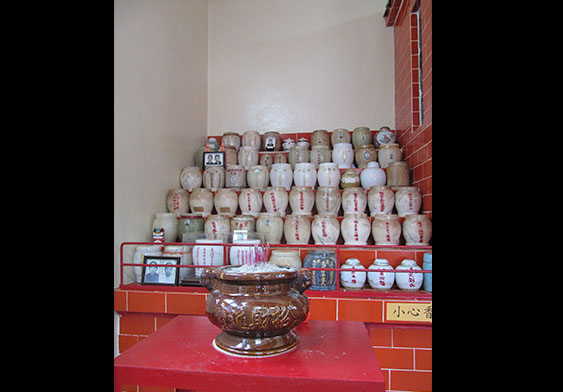
The village’s ancestral hall’s ash niches
Ng Siu Kei’s grandfathers’ and parents' soul tablets are all placed in the ancestral hall for worship-Photo taken by HKMP Team (2012)
The village’s ancestral hall’s ash niches
Ng Siu Kei’s grandfathers’ and parents' soul tablets are all placed in the ancestral hall for worship-Photo taken by HKMP Team (2012)
Funeral rites
When Ng Siu Kei’s grandfather and father passed away, their funeral ceremonies took place in front of the gatehouse. Many villagers demonstrated their high regard for the two deceased elders by holding night vigils or helping to cook congee and frying noodles for late night snacks. When bidding farewell to her father-in-law’s coffin, Ng Siu Kei’s wife was pregnant. While not kneeling in line with clan rules, she still donned a sackcloth mourning dress and carried the traditional bunch of ginger, a ‘lai see’ red packet. In the past, villagers in Nga Tsin Wai were viewed as being indigenous inhabitants and had the right to be buried on the hilltops near the village walls. Such rights were subsequently abolished.
Ng Siu Kei’s grandfather was initially buried in the graveyard of Tsing Shan Monastery. As a result, his father who attached great importance to worshipping ancestors made it a rule that all family members must go to Monastery to worship the old man at least once a year. Ten or so years later, the graveyard was damaged. Owing to the difficulty and huge expenses involved in carrying out repairs, Ng Siu Kei and his brothers resolved to unearth their grandfather’s bones. Their plans also involved cremating the remains and then placing the ash in Ng Clan Ancestral Hall for worship. Ng Siu Kei’s father was buried in Wo Hop Shek and his bones were unearthed and cremated upon the expiry of the seven years’ tenure of the graveyard. His ashes were then reinterred in the ancestral hall for worship.


 BACK
BACK  CLOSE
CLOSE 